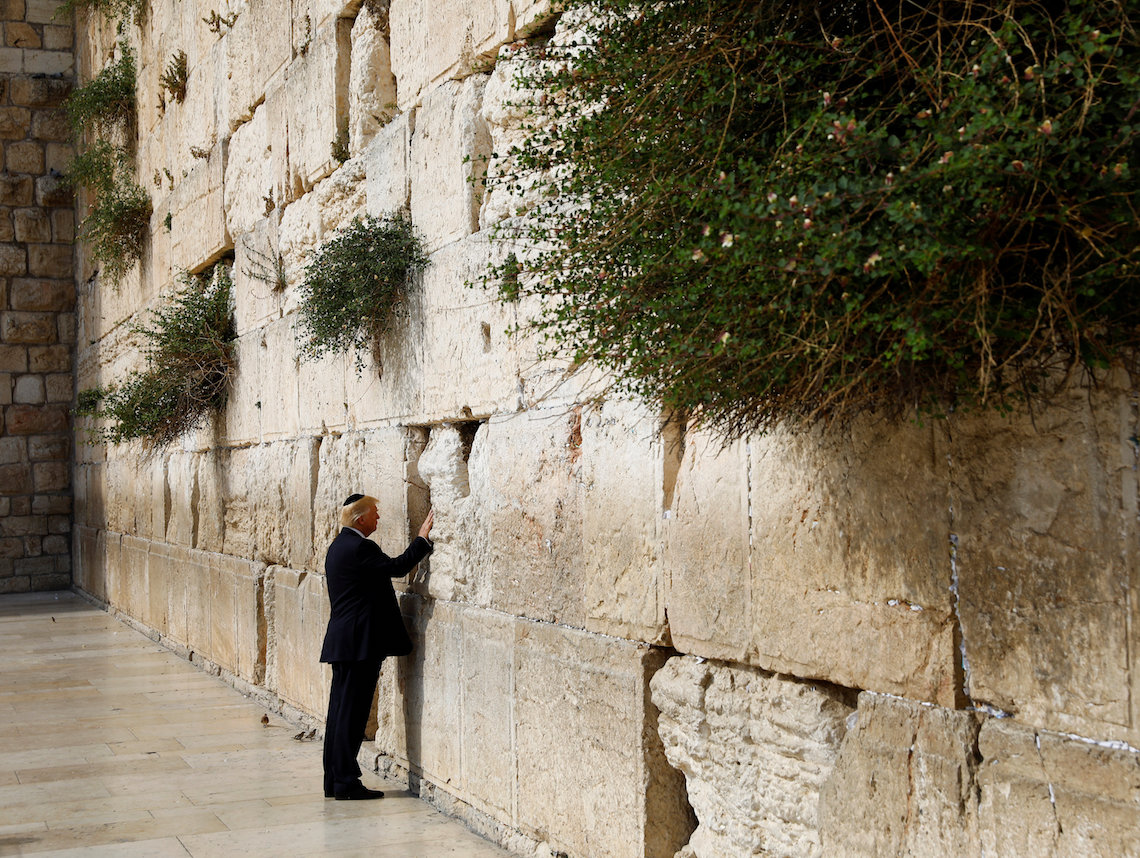
President Donald Trump touches the Western Wall on May 22.
Hopeful rhetoric, vague vision for peace after Trump’s Middle East visit
President Donald Trump has come and
gone from his trip to the Middle East, his first foreign excursion
since taking office earlier this year. He arrived — first in Riyadh,
Saudi Arabia, then Jerusalem and Bethlehem in Israel — with strong words
about Iran as the neighborhood bully and, like so many American
presidents before him, buoyant words for the Israeli and Palestinian
people.
Optimistic words. Hopeful words. They all
conveyed a vision and new possibility for peace in the region, a
prospect “I’ve heard,” he said, that is “one of the toughest deals of
all. But I have a feeling we will get there eventually, I hope.”
Good for Trump. A new American president. A new chance for a solution. A new team to get it done.
But where were the new ideas Israeli
leaders are so certain he has? What is the new approach? How does he
propose to untangle the thorny issues on the ground — boundaries,
settlers, Jerusalem, etc. — that have left so many presidents before him
bloody with failure?
Peace between Israelis and Palestinians
was a topic of much discussion when Trump visited Jerusalem and
Bethlehem. It was front and center, but not necessarily the first item
on the agenda. In his speech to the Arab world in Riyadh days before, in
his unscripted photo-op with Prime Minister Benjamin Netanyahu, in his
later remarks in the prime minister’s house, Trump was more focused on
Iran as the source of menace in the region. He and Netanyahu suggested
that there are new opportunities in the region. Countries must unite
against a common threat — Iran. That’s an opening that can be explored.
Michael Oren, historian, former
Israeli ambassador to the United States and currently Israel’s deputy
minister for diplomacy, said he believes that this new reality is a
conduit of a “tremendous” shift. If once it was assumed that a peace
with the Palestinians could lead to reconciliation of Israel with the
rest of the Arab world — the situations is now reversed: A peace with
the Arab world could lead to a deal with the Palestinians. If the Saudis
come on board, if other Gulf states come on board, if the Arab world
realizes that fighting against Israel makes no sense in this era of
radicalism, the Palestinians might realize that the train of peace is
leaving the station and that they’d better hurry so they don’t miss it.
Maybe this is what Israeli leaders mean
when they constantly talk about “new ideas.” Trump is a devotee of “new”
ideas, “bold” ideas, “different” ideas. For Israel, to resist his push
for a deal would be a mistake. But it might be able to convince him that
his predecessors failed because of their conventional thinking — and
that he, a man bold enough, ought to reformulate the meaning of the
ultimate deal. The “two-state solution” is old, tired — and it is so
Clinton and Obama. Trump could make his mark by thinking outside of the
box, that is, by dropping old ideas and replacing them with new ideas.
Israeli President Reuven Rivlin sang the
praises of new ideas after his meeting with Trump: “Our destiny —
Palestinians and Jews — is to live together in this land,” he said. “In
order to achieve this, we need new ideas, new energy that will help us
move forward, together.”
But move where? Rivlin has his new ideas;
he supports one state, or a confederation of Israelis and Palestinians.
Naftali Bennett, the head of the Jewish Home Party and the leader most
forthright in attempting to directly tell Trump what needs to be done
(“We expect you to be the first president to recognize a united
Jerusalem,” he said, to which Trump responded, “That’s an idea!”), has
different new ideas. He supports an autonomy for Palestinians and
annexation of the rest. Other leaders also have new ideas, including the
oldest “new” idea of sticking to an improved status quo.
Does Trump have new ideas? If he does, we
were still waiting to hear what they are as he departed for Europe. It
was worth noting that Trump refrained from using the term “two-state
solution” during his visit. It is possible that he is more open than his
predecessors to considering alternative ideas, assuming he has them. In
Saudi Arabia, in Jerusalem and in Bethlehem, he kept hinting that his
deal is partially built on the goodwill of the conservative Arab regimes
of Jordan, Egypt and Saudi Arabia. Former President Bill Clinton failed
to get them on board at Camp David. He was disappointed by their
refusal to help him push the late Yasser Arafat, chairman of the
Palestine Liberation Organization, toward accepting the deal that was
offered to him. Trump and some of his top advisers believe circumstances
have changed in a way that could make such a push more realistic today.
His brief trip was barely a beginning of a
long process of exploration of these assumptions and ideas. Although it
sent a symbolic message of involvement and new energy, it did little to
advance a detailed vision of a peace process. And of course,
involvement is crucial, as both Arab and Israeli leaders made clear in
their remarks, taking a swipe at the Barack Obama administration.
“We are happy to see that America is
back,” said Rivlin, usually not the type to bash the former president.
Netanyahu, not surprisingly, was more direct: “I want to tell you also
how much we appreciate the reassertion of American leadership in the
Middle East.”
The new American president ought to
know that there is no correlation between the number of visits to the
Middle East and the level of success in handling Middle East affairs.
Yes, Trump made “history” — a word used much too often to describe
routine events — in going to Israel and Saudi Arabia earlier in his term
than any other president. He made “history” again by being the first
sitting American president to visit the Western Wall. So what? Nixon
made history by being the first president to travel to Israel. Shortly
afterward, he was forced out of office. Clinton made history by coming
to Israel more than all other presidents, four times. It did not
guarantee his success.
The only presidential visit that really
made a change was Jimmy Carter’s in 1979. That was a dramatic visit,
with ups, downs and crises. It was a make-or-break visit: Carter
traveled to Egypt, then to Israel, and forced the hand of the late
Israeli Prime Minister Menachem Begin to accept the peace deal that was
proposed to him. A few years ago, Israel’s state archives released
documents from that visit, including a cable that was sent from Zvi
Rafiah, Israel’s then-liaison to the U.S. Congress. Carter briefed
congressional leaders when he was back in Washington, D.C., and Rafiah
reported to his superiors in Jerusalem that during this meeting, Carter
described his meeting with the Israeli cabinet as “terrible.”
“Terrible” and “horrible” are two of
Trump’s favorite words. So maybe he will also describe parts of his
visit as terrible. Maybe he did not appreciate the food, or the heat, or
the forced selfie with Knesset Member Oren Hazan. But as far as we
know, by the end of his visit on May 23, nothing truly “terrible”
happened. Everybody was nice to him. Everybody agreed with him.
Everybody encouraged him to keep doing what he is doing, whatever that
is.
A time for confrontation might still
come, when a more detailed plan emerges, and a real price is demanded of
the parties. Already, Israel and the Palestinians got a taste of the
future. Israel watched reluctantly, yet silently, as the Saudis bought
weapons in quantities that might put Israel’s military edge at risk. The
Palestinians witnessed an American president visiting the Kotel. They
heard an American president, not for the first time, raise the issue of
terrorism as an obstacle they need to overcome to achieve their
objectives. They heard him say “peace” but not “a Palestinian state.”
And so. There was a visit and it went
smoothly. For Trump, that is certainly an achievement. Everybody was
trying to convince everybody that the visit was successful and that
Trump is exactly what they expected him to be.
But there was reason for caution. On the
evening of May 22, about an hour before Trump and Netanyahu made their
joint statement in Jerusalem, I was sitting in a radio studio in the
city of Modi’in. The interviewee on the line was Member of Knesset Ahmad
Tibi, an Arab legislator, an articulate critic of Israel’s policies,
and a frequent visitor at the offices of Mahmoud Abbas, the Palestinian
president.
He was cautious. Very cautious. Wisely
cautious. Tibi has hopes, but he isn’t letting them get too high. He
knows Trump changes his mind, he said. He knows it is not yet clear what
Trump wants, beyond the generalities of having a “deal” and brokering
“peace.” He knows Trump won’t always have the patience necessary to see a
bumpy peace process through. And so Tibi’s message was simple: I’ll
believe him about his Israeli-Palestinian peace effort when I see it.
When I asked Tzachi Hanegbi, Israel’s
communications minister, about Trump reportedly walking back on his
campaign promise to move the American embassy to Jerusalem, Hanegbi
didn’t even blink before explaining that a visit to the Western Wall is
much more important than moving the embassy. And when Tibi was asked if
he was annoyed by Trump’s visit to the Kotel, Tibi didn’t even blink
before explaining that it was an insignificant event that reinforced the
fact that the U.S. does not recognize the site as Israeli.
Despite what did and didn’t happen, give
Trump credit for this: He was polite, almost gaffe free and vague enough
to keep the valuable posture of a Rorschach test: for now, all
interpretation of his actions and intentions are still in the eye of the
beholder.
 | |||||||||||||||||||||||||||||||||
| HEY GOD - WHERE'S YOUR NOTE TO ME? |




